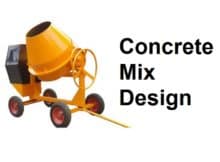The construction industry uses two main types of concrete, such as ready-mix concrete and site-mixed concrete. Both types have their specifications, purposes, and applications. In this article, we will discuss what is ready mix concrete, its advantages, disadvantages, application, etc.
What Is Ready Mix Concrete?
Ready mix concrete or RMC is made in a factory or within a batching plant instead of the worksite and transported to the construction site in an unhardened and plastic state. It is delivered in a condition ready to use.

The ready-mix concrete is usually preferred for large projects that require a high volume or when less space is available for storing and mixing the construction materials.
The plant-made concrete is loaded into special delivery trucks called the transit mixers which have the provisions to constantly rotate and keep the concrete in motion and thus prevent setting.
Usually, retarders are added to the concrete mix to slow down the setting process to give allowance to the transportation and placing time of the concrete.
Quality check is performed both in the factory and at the site. The difference in the slump value of both should not differ by more than 25 mm or 1/8th of the specific value whichever is greater.
Types Of Ready Mix Concrete
There are three types of ready mix concrete described below.
- Transit mixed concrete
- Shrink mixed concrete
- Central mixed concrete
1. Transit Mixed Concrete
It is the most common type of ready-mix concrete used by building construction providers. The concrete ingredients are batched at the manufacturing plant and then added to the transport truck.
While transporting from the plant to the job site, the ingredients are thoroughly mixed in the truck mixer to produce the concrete. It is also known as truck mixed or dry batched concrete.
This method of mixing segregates water from the cement and prevents the issues of slump loss or early hardening of the concrete. There are three major types of transit mixed concrete
- Concrete mixed at job site
- Concrete mixed in transit
- Concrete mixed in the yard
2. Shrink Mixed Concrete
This type of concrete is entirely prepared at the manufacturing plants. The ingredients are added to the batching plants, and the required adjustments are made according to the strength requirements of the concrete.
The ready-made concrete is then shifted through concrete pumps for transportation. The main purpose of this concrete is to increase the load capacity of the transporting vehicle. The balance mixing of the concrete is done during the transit time.
3. Central-Mixed Concrete
This type of ready mixed concrete is used when the quality of the batch needs to be perfect. The concrete is mixed and set at a stationary unit, and then it undergoes all the significant tests to ensure its proper quality.
The concrete is only allowed to be transported to the construction site once it is approved after tests. It is also known as wet batch plants. However, the process is time-consuming and not always recommended.
Advantages of Ready Mixed Concrete
1. One of the biggest advantages of RMC is that concrete is produced under controlled conditions. The use of high-tech equipment, consistent methods produce excellent quality concrete.
2. The use of ready mix concrete allows high-speed construction through programmed delivery at site, mechanized operation. Using RMC concreting can be done at a rate of 30-45 cubic meters per hour whereas traditional mixing methods only allow 15-20 cubic meters per hour. Speed matters a lot.
3. Better handling and proper mixing practice reduces cement consumption by 10 – 12%.
4. Less time-consuming and delivered in ready-to-use condition. Can easily be delivered to multiple sites within a project.
5. RMC helps to reduce the labor cost and site supervising cost.
6. Does not require storage of construction materials at the site.
7. Less air and noise pollution at the job site.
8. Wastage of materials at the site is minimal.
9. Economy in the use of raw materials results in conservation of natural resources.
10. Small or large quantities of concrete can be delivered timely at the construction site.
11. More durable structures are obtained thus increasing the service life and saving the life cycle costs.
12. It reduces man-made errors at the site as RMC has less dependency on human laborers.
13. Ready mix concrete is environment-friendly.
Disadvantages Of RMC
1. The initial investment is very high.
2. Not suitable for small construction projects where less quantity of concrete is required.
3. Need an effective transportation system from the batching plant to the job site.
4. Labors should be ready at the site to cast the concrete in position without any delay to avoid slump loss.
5. Ready mixed concrete has limited time and should be used within 210 minutes of batching the plant. Traffic jams or breakdown of the vehicle can create major problems.
Applications
- Monolithic concreting for the roof slabs and beams,
- Runways,
- Pavements,
- Lining of tunnels,
- Dams and hydraulic structures.
Conclusion
Quality Control of ready mix concrete is very important as it has to be mixed with a proper dose of admixtures and transported to different locations. All the ingredients of concrete are thoroughly tested before concrete production to ensure better quality.
Everything is taken care of by batching plants during manufacturing the concrete mixt to produce highly durable, sustainable, and premier quality for long-lasting structures.
Also Read
Difference Between Ready Mix Concrete & Site Mix Concrete
Roller Compacted Concrete – Advantages & Disadvantages
If you like this article, then please share it with your friends & also like our Facebook Page and join our Telegram Channel.




